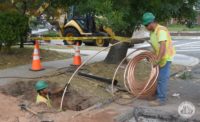Chicago, the American city with the most lead pipes, has begun the process of pipe removal under a voluntary, multiyear program from the city's department of water management and Mayor Lori Lightfoot.
“Chicago’s lead service lines are a legacy issue we need to start meaningfully confronting by moving in the right direction in a responsible way,” Lightfoot said at a news conference announcing the program September 9. “The new Lead Service Line Replacement Program stands as our equity-forward approach to providing residents the support they need, all while providing a foundation to continuously building on our commitment to addressing this important issue for the long term.”
In 2021, Chicago plans to replace 750 of the roughly 400,000 lead service lines that connect homes to street mains. The mains were replaced by other types of pipe during the administration of Mayors Richard M. Daley and Rahm Emanuel.
The voluntary line service replacement program will require passage of an ordinance by the Chicago City Council which Lightfoot said she expects will happen in November. Homeowners that make less than about $72,000 a year for a family of four, with water tests that show consistent lead concentration at 15 parts per billion, can apply for a free replacement. $15 million in grant funding next year will cover the 2021 replacements, but the program is unfunded beyond that. Homeowners that choose to hire a contractor to do the work are eligible for a permit waiver of about $3,000. Mayor Lightfoot said officials estimate it will be an $8.5-billion program.
“We have been replacing miles of aging water and sewer mains for years, some almost a century old. When we open the ground we frequently encounter unanticipated issues. This is why a project involving water main and lead service line replacement performed at the same time is so important,” said Water Management Dept. Commissioner Randy Conner. “It is enormously helpful to understand what other cities have learned in their programs, but each city and its infrastructure are different.”
Congress banned lead water pipes in 1986, but previous mayors and the Chicago City Council have been reluctant to replace the service lines with Emanuel, Daley and, until recently, Lightfoot insisting that a corrosion-inhibiting chemical coating introduced into the water system for decades coated off the interior of the lead service lines and took care of the problem of lead leaching off of them and getting into drinking water.
There is no federal standard for the amount of lead in tap water that can be allowed from individual homes. Utilities are considered to be in compliance with EPA regulations as long as 90% of the homes tested in a city have lead levels below 15 ppb, according to the agency's lead and copper rule, which was first set in 1991. The agency believed, at the time, that lead pipes could be managed with corrosion-inhibiting chemicals like the ones used in Chicago, although there have been revisions to the rule since.
Virginia Tech Professor Marc Edwards showed how cherry picking which homes were tested in both Washington, DC, and Flint, Mich. could create an inaccurate picture that doesn't show how many are truly in violation of the 15-ppb standard. After Edwards' work in Flint, the statewide standard in Michigan was lowered to 10 ppb.
"We have learned the hard way that nobody drinking water from a lead pipe is safe— I applaud Chicago for taking the first small step on what will be a very long journey," Edwards says. Edwards and his team from Virginia Tech have sampled in Chicago, particularly on the South Side, and found that routine flushing does not reduce lead there as it does in other cities.
In an October 2016 white paper, the EPA admitted the standard is inadequate to protect consumers, not only because of the 15-ppb threshold but also because the rule itself is so complicated and testing is so complex that it gives utilities too much leeway in proving that the 90% part of the standard has been met.
Chicago conducts tests in just 50 homes every three years — the minimum required by the EPA. Most of the homes tested are owned by water management department employees or retirees living on the northwest and southwest sides. Results from some of Chicago's free testing kit program tests show lead-contaminated water has been found in at least one home in all 77 community areas in Chicago.
“The current structure of the rule compels additional protective actions on the part of a water system only after a potential problem has been identified, which may create a disincentive for utilities to identify potential problems with lead and copper in the drinking-water system,” the EPA said in the 2016 white paper.
Mayor Emanuel spent more than $475 million throughout his three terms as mayor from 2011 to 2019 replacing water mains in Chicago. He also doubled water rates to pay off debt accrued by the projects, but consistently stopped short of replacing the service lines. It's not known exactly how many homes in Chicago have lead service lines, but it's believed to be close to the 400,000 number the department of water management estimates. For comparison, 125,000 homes have them in Detroit.






Post a comment to this article
Report Abusive Comment